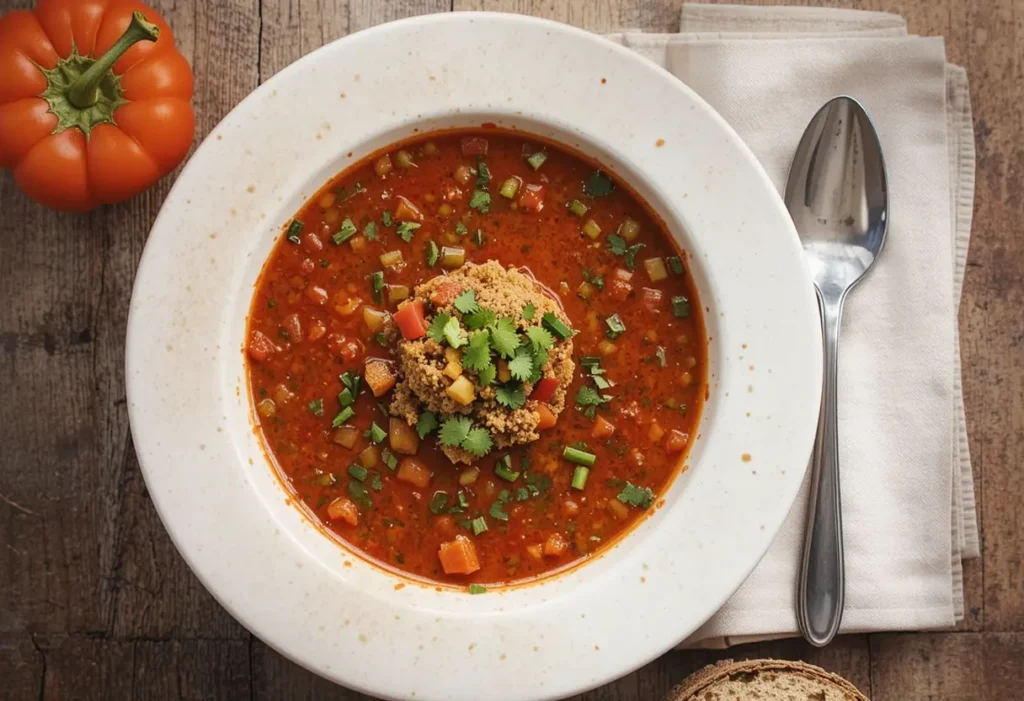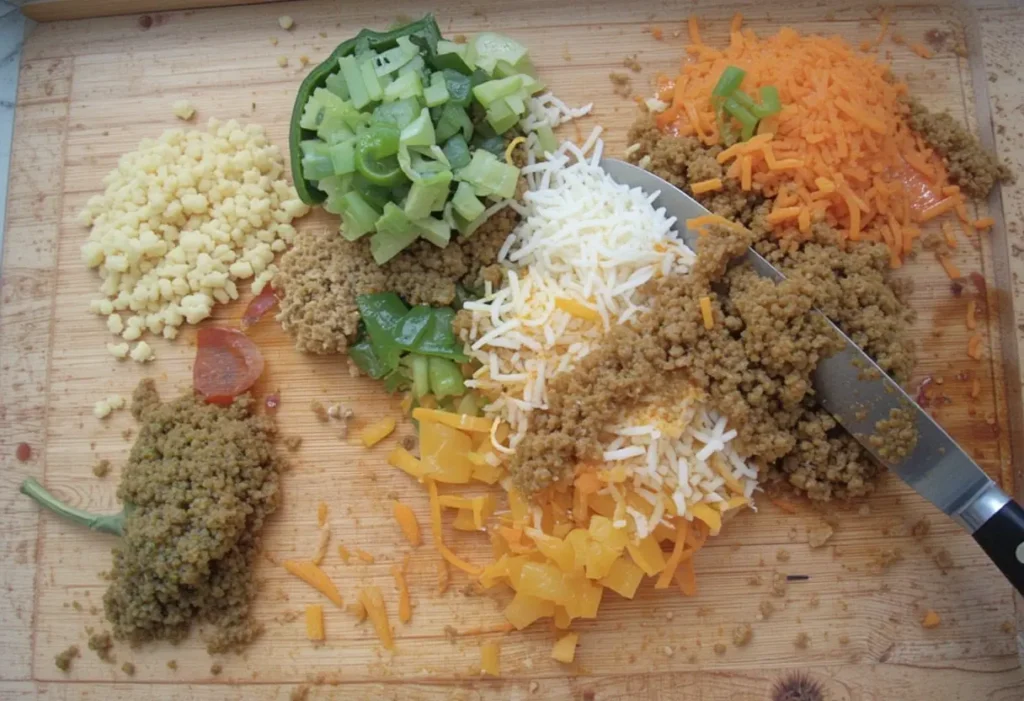A Comprehensive Guide
Preparing stuffed pepper soup begins with mastering the art of cutting peppers. Properly cut peppers ensure even cooking, enhance flavor integration, and elevate the dish’s overall presentation. This guide covers every step, from selecting the right peppers to practical cutting techniques, to help you create an impeccable stuffed pepper soup.
Stuffed pepper soup is a warm and hearty dish loved for its simplicity and rich flavors. If you are exploring this dish for the first time, check out this detailed stuffed pepper soup recipe to complement the techniques discussed here.
Why Properly Cutting Peppers Is Essential
Accurate cutting techniques are not just about aesthetics—they are essential for:
- Uniform cooking: Evenly sized pieces ensure consistent cooking times.
- Enhanced flavor release: Smaller, well-cut pieces distribute flavor more effectively.
- Reduced waste: Proper cuts maximize usable portions of the pepper.
- Visual appeal: Beautifully diced peppers add a professional touch to the soup.
Whether you’re making a hearty soup or experimenting with sides, such as the suggestions from what do you eat with stuffed peppers?, mastering pepper cutting makes all the difference.
Selecting the Best Peppers for Stuffed Pepper Soup
Bell peppers are the traditional choice for stuffed pepper soup due to their sweet flavor, vibrant colors, and easy availability. Here’s how to choose the perfect peppers for your dish:
Color and Flavor Profiles
- Red peppers: Sweet, mature, and ideal for adding depth to your soup.
- Green peppers: Earthy and slightly bitter, balancing the sweetness of other ingredients.
- Yellow and orange peppers: Mild and fruity, bringing brightness to the dish.
How to Choose the Freshest Peppers
- Look for firm, shiny skin without wrinkles or soft spots.
- Check the stem—it should be green and fresh-looking.
- Opt for peppers that feel heavy for their size, indicating juiciness.
When deciding on quantities, consider using a mix of colors for a visually appealing soup that balances sweet and savory flavors.
Essential Tools for Cutting Peppers
Using the right tools makes the cutting process safer and more efficient. Here’s what you need:
- Chef’s knife: A sharp, high-quality knife ensures clean cuts and reduces effort.
- Cutting board: Choose a non-slip board for stability during cutting.
- Optional tools: Pepper corers or small paring knives make it easier to remove seeds and membranes.
Investing in good kitchen tools improves your overall cooking experience. For beginners, explore a list of essential kitchen tools to simplify food prep tasks.

Preparing Peppers Before Cutting
Preparation is an essential step to ensure your peppers are clean and ready for cutting:
- Wash thoroughly: Rinse under cold running water to remove dirt, pesticides, or bacteria.
- Dry completely: Use a clean towel to pat them dry, as moisture can make peppers slippery.
- Inspect for damage: Remove blemishes or soft spots with a small knife.
Step-by-Step Guide: How to Cut Peppers for Stuffed Pepper Soup
Cutting peppers the right way makes a significant difference in your soup’s texture and cooking time. Here are the two best methods for cutting peppers for stuffed pepper soup:
Method 1: Cutting Off the Top
- Place the pepper upright on the cutting board.
- Use a sharp knife to slice across the top, removing the stem.
- Pull out the core and seeds by hand or with a spoon.
- Slice the pepper into rings, then dice each ring into smaller, uniform pieces.
Method 2: Cutting the Pepper in Half
- Lay the pepper horizontally on the cutting board.
- Slice it in half lengthwise from top to bottom.
- Remove seeds and membranes from each half using your fingers or a small knife.
- Flatten the halves on the board and cut into strips or cubes.
Tips for Consistency
- Uniform pieces: Dice peppers into similar sizes to ensure even cooking in the soup.
- Scraps for broth: Save the seeds and tops for making homemade vegetable broth.
For more insights on proper preparation, explore how these techniques enhance other dishes like 4-ingredient potato soup.
Common Cutting Mistakes to Avoid
Even experienced cooks can make errors when cutting peppers. Here’s how to avoid common pitfalls:
- Overcutting: Avoid creating pieces that are too small—they can turn mushy during cooking.
- Inconsistent sizes: Uneven cuts lead to some pieces being undercooked while others overcook.
- Discarding usable parts: Use as much of the pepper as possible to reduce waste.

Storage Tips for Pre-Cut Peppers
If you’re preparing your peppers ahead of time, proper storage ensures they stay fresh:
- Refrigeration: Place pre-cut peppers in an airtight container lined with a damp paper towel. This keeps them crisp for up to three days.
- Freezing: Lay the pieces flat on a baking sheet to freeze individually. Once frozen, transfer them to a freezer bag to avoid clumping.
Pre-cut peppers are ideal for meal prep and work well in appetizers like pepper soup as an appetizer.
FAQs About Cutting Peppers
1. How do I cut peppers to ensure even cooking in soup?
Dice peppers into uniform pieces using either the “cutting off the top” or “halving” methods. Uniformity ensures all pieces cook evenly.
2. What’s the easiest way to remove seeds?
Cutting off the top allows you to pull out the seeds and core in one motion. A spoon or corer can also help.
3. Can pre-cut peppers be used for stuffed pepper soup?
Yes, but ensure they are fresh and properly stored to retain flavor and texture.
4. Do I need to peel peppers for this soup?
No, the skin softens during cooking and adds texture to the dish.
5. How do I choose the right peppers for this recipe?
Opt for fresh, firm bell peppers with vibrant colors and no soft spots. A mix of red, green, yellow, and orange peppers adds balance.
Advanced Tips for Cutting Peppers
1. Reducing Waste
- Use scraps (stems, seeds, and membranes) to make a flavorful vegetable broth.
- Freeze extra pieces for use in stir-fries or stews.
2. Speed Up the Process
- Invest in a mandoline or dicing tool for faster and more uniform cuts.
- Practice your knife skills to improve speed and accuracy.
3. Enhance Presentation
- Slice thin rings for garnishing soups or salads.
- Use vibrant pepper colors strategically to make dishes more visually appealing.
Complementing Your Stuffed Pepper Soup
Pair your soup with complementary dishes to create a balanced meal. For example:
- Bread-based sides like cornbread or savory bread pudding make an excellent choice.
- Light salads or grilled vegetables enhance the soup’s nutritional profile.
Conclusion
Mastering the art of how to cut peppers for stuffed pepper soup ensures your dish is not only flavorful but also visually appealing and perfectly cooked. By choosing the right peppers, using proper tools, and following step-by-step cutting techniques, you can elevate this simple comfort food into a standout meal.
For more inspiration, explore related recipes and meal ideas on Tomaderecipy. Happy cooking!


1 thought on “How to Cut Peppers for Stuffed Pepper Soup?”
Comments are closed.